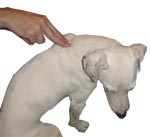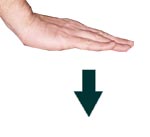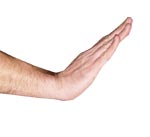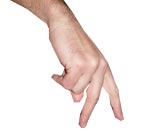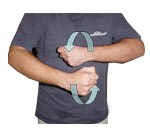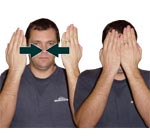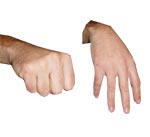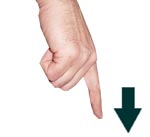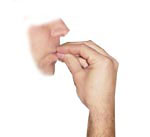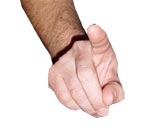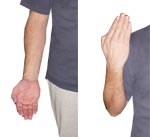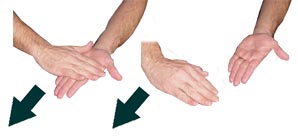The purpose of a correction in dog training is not to punish a dog for inappropriate or bad behavior rather the purpose of a correction is to change a dog’s behavior.
Understanding corrections is the core of understanding dog training.
One of the biggest problems I see with new trainers is they give ineffective corrections that don’t change behavior. What they do is nag their dog to death. Nagging corrections desensitize a dog to a correction. Nagging corrections simply teach a dog that they don’t need to pay attention to the handler.
There are also those trainers who feel the need to punish a dog with a correction. Those handlers can train a dog but they never have what I consider a deep bond with their dog.
The purpose of this article is to shed light on when to apply corrections is a training program. I will also provide food for thought on determining what kind and what level of correction to give dogs who all have varying temperaments.
Dog’s, like people, are individuals. A correction that results in a behavior change for one dog will have no effect on another dog. Simply withholding a food reward or toy reward for many dog’s produces behavior changes, while an off leash high drive dog facing strong distractions is going to require remote collar corrections to get behavior changes.
Not only do different dogs require different kinds of corrections, every dog require different levels of corrections based on the type of distraction they are facing. By that I mean the dog that needed a voice warning in one circumstance may need a pretty strong leash correction when faced with much higher levels of distraction.
For me the ART OF DOG TRAINING means understanding temperament, understanding motivation, but more importantly understanding levels of distractions, and corrections.
Trainers who give a prong collar correction to a dog that would have offered a behavior change with a verbal warning are abusing their dog. That trainer is only harming their relationship with that dog.
All-Positive Trainers
In the past 15 years we have seen many all-positive trainers (otherwise known as “+P” trainers) who mistakenly think they can train every dog and never give a dog a correction. These people either lack experience or they know better and simply talk the talk so they can be politically correct.
Not in a million years could any +P trainer anywhere have trained or certified any one of the police service dogs that I worked while I was a K9 handler.
In fact 99.99% of every dog trained in the +P system will eventually be faced with a off leash distraction that is more interesting to that dog than the reward his handler has to offer. When that happens the dog will not follow his owner’s commands, even though the dog knows exactly what his owner is asking. That’s how dog’s get into dangerous situations. This is how +P dog's get in dog fights or hit by cars.
I also don’t have a lot of patience for +P trainering organizations (like Pet Smart) that push purely positive dog training in their training classes and won;t let their trainers talk about corrections. They do a dis-service to new dog owners who makes the mistake of taking their classes.
The fact is there will come a time when every handler is 100% sure that his or her dog fully understands what he is asking his dog to do but the dog ignores the command. When that happens that dog needs some form of a correction to get compliance.
All-positive trainers always point to sea world's dolphins and killer whales as proof of their system. They pontificate about how impossible it would be to give a killer what a correction.
Well anyone with half a brain can see that these dolphins and killer whales are forced to live in very small pools that have zero distractions. Taking human interaction and withholding food rewards from an animal that lives in social isolation is in and of itself a pretty strong correction.
I stand with those folks who think what Sea World does to their animals is cruel and unusual punishment. How they force these animals to live is disgusting. Their claims of using operant conditioning is a scam.
I Consider Myself a "Balanced Reward-Based Trainer"
I consider myself a “balance reward based trainer”. I will start by explaining what that means.
I believe in teaching behaviors by using high value rewards (both food and toy rewards). I train behaviors with markers. Marker training (some call it clicker training) is simply a language we use to communicate with our dog while training behaviors.
If you are unfamiliar with marker training I wrote that explains the concept, The Power of Training Dogs with Markers.
In our training system I never correct a dog until I am 100% sure I know the dog knows exactly what I am asking him to do but it makes a conscious decision not to perform the behavior I am asking because the distraction the dog is facing is more interesting to that dog than the high value reward I have.
The 5 Core Words of Marker Training
In marker training the dog learns the meaning of 5 core words that we will use in our training for the duration of a dog’s life.
Those words are” READY, YES, NO, GOOD, and DONE. A quick review of how these words are used to communicate with the dog:
- READY is used to tell our dog we are about to either start training or we are going to has him to do something
- YES means we like what he is doing and he is now released to do what he wants until we ask him to do something else. Some trainers call this a RELEASE.
- NO means the dog didn’t perform the behavior well enough to get a reward and if he wants the reward he has to try again. NO is not a correction. It is not said in a scolding tone of voice. NO simply means NOPE YOU DIDN’T GET TI RIGHT – TRY AGAIN.
- GOOD is a continuation command. That means we like what e is doing and we expect him to continue doing it until we give him the release command of YES. So if we take a trained dog and tell him to DOWN – the dog is expected to stay DOWN until we release him with YES.
When a dog understands a RELEASE Command and a Continuation Command it does not need to learn STAY because it knows it has to continue doing what it is doing until we release it.
5. DONE simply means our training session is over. At the end of every training session we say ALL DONE and the dog will learn through repetition that he is free to do what he wants because we are thru with the training session or the work session.
Once a dog understands these 5 words we can use them to teach any behavior we want to train. The dog will learn that if it does what we want we will give it a “high value reward.”
High value rewards vary from dog to dog. When we are dealing with food rewards almost every dog is different. A high value reward for one dog could be small pieces of leftover steak from last nights dinner while a high value food reward for another dog will be a small piece of cheese or a piece of hot dog or a piece of chicken. It is the job of the trainer to experiment with their dog to find out what food trips their dogs trigger. In fact it is the handlers job to actually come up with a ranking system for several different kinds of food rewards. The purpose for that is explained in other articles.
The same concept applies to toys. My dog may want to die for a rubber ball while your dog would die to play with a tug toy and other dog’s would rather play with a small squeaky toy over anything else.
Once we establish the rewards to use (which is usually done during marker training) we teach the dog that if he does what we ask he will get a reward. When that reward has a high enough value to the dog and we tell the dog NO you did it wrong, the dog will want to repeat the behavior again. When the dog has a strong enough drive for the reward it figures out the road to that reward is to do what you ask and do it correctly.
This always takes repetition, repetition repetition. Some dogs will learn a behavior in just a few reps, while others need a hundred reps.
During the foundation of teaching behaviors we never correct a dog for not performing the behavior correctly. We simply withhold the reward and ask the dog to try again. From a true scientific position “withholding a reward can be looked at as a correction for some dogs”. In our case we don’t look at it like that.
I am not sure who came up with the concept that a dog has to perform a behavior correctly 3 times in a row without any mistakes before he is considered to know the behavior we ask for. I do know that my friend Tom Rose used that saying back in the late 1980’s. I have always liked that concept. Throughout training we never correct the dog for failing to perform the behavior.
If during training the dog simply quits trying, if it has not generalized the behavior or if it looks confused because we expected too much too soon we either dumb down the behavior my simplifying what we expect or we simply put the dog away. We NEVER correct the dog for not trying.
When Do We Start to Correct the Dog?
When I say that a dog has generalized a behavior that means it knows the meaning of a command in every environment you chose to put it in.
We don’t start to correct a dog until after our dog has generalized a behavior in the environment we put the dog in.
When I say a dog has generalized the command SIT in your back yard this means it will SIT every time you ask him to SIT when he is in your back yard. We say the dog has generalized the SIT in your kitchen that means it will SIT every time I ask it to SIT when it is in your kitchen.
To get a dog to generalize a behavior we begin our training in a distraction free environment. Once the dog performs the behavior in that environment we slowly add distractions. We look for the dog that can perform the behavior multiple times in a row under the current level of distraction before we increase distractions.
In the beginning these distractions are very small but as we see fluency under distractions we will slowly increase the level distractions. We do not correct a dog if it gets distracted because we (the handler) made the mistake of increasing the distractions too quickly. That’s not the dog’s mistake, it’s the handler mistake.
The difference between Force Training (or Avoidance Training) vs. using Corrections
There is a huge difference between using correction to change behavior in a trained dog and having a training system which is based entirely on teaching dog’s to comply by avoiding corrections.
If you are around dog trainers long enough you will hear the term "FORCE TRAINING - or AVOIDANCE TRAINING ". Force training is old school training and it works. I know because I did it for 30 years.
In its simplest form avoidance training simply means we teach the dog to avoid correction by complying too what we want.
Thirty years ago we used to teach our dog to heel by walking down the field with our dog on leash and on our left side. We would make a right turn, give a leash correction as we gave the heel command. Eventually the dog figured out that if it paid attention to what we were doing it could read our body language and anticipate a turn thereby avoiding an automatic leash correction. That was avoidance training.
Unfortunately when the timing is not perfect, and it usually isn’t with new dog trainers, it damages the relationship between the dog and the handler. Their dogs become confused, stressed and depressed.
On the other hand when the timing is perfect avoidance training is the fastest way to train a dog. It is much faster than reward based training. There is no question about that.
Professional trainers who have a limited amount of time to teach a client’s dog behaviors have to use avoidance training. They don’t have a choice. They don’t have 3 or 4 weeks to establish the foundation in marker training and then teach behaviors with reward based training. At best they have 2 or 3 weeks with a dog and they need to get that dog to the point where the owner can see progress.
I used to fault professional trainers. I was dead wrong. They perform a service to people who will never take the time to learn how to train a dog.
So it is important that new trainers understand that correcting a dog for refusing to comply with a command that it absolutely knows the meaning of IS NOT forced avoidance training, at least not in my book.
The art of dog training is to know what kind of correction to apply and what level correction to give (within a range of very slight to very hard).
NEGATIVE PUNISHMENT
Negative punishment means we take something away from the dog as punishment. In other words we don’t reward the dog.
There is a concept in dog training called negative punishment. Negative punishment is used by trainers who use food rewards and toy rewards. It simply means when a dog makes mistakes the trainer says "NOPE - YOU DON'T GET YOUR TREAT; YOU HAVE TO DO IT AGAIN" or "NOPE - YOU DON'T GET THIS TOY". There is no physical correction because withholding the reward is enough punishment for many dogs, s withholding the reward becomes the negative punisher.
This concept is explained in detail in the DVDs I produced with Michael Ellis titled The Power of Training Dogs with Food and The Power of Playing Tug with Your Dog.
With repetition dogs learn to understand this concept. If we are training jumps and our dog knocks the top bar down and we simply say "NOPE - you have to do it again," the dog turns and runs back to the start position and waits while we reset the bar. There is no anger or threat involved and there is no change in your voice to signify a change in your attitude.
Another example of this uses pet dogs that jump up on the owner. When the owner has a reward in hand (food or a toy) and the dog jumps on them, they simply say "NOPE" and wait until the dog backs off before giving the high value reward. If the reward has a high enough value to the dog, it will not take long for the dog to learn that the only way to get the reward is to NOT JUMP UP on his owner.
Positive Punishment
Positive punishment means the dog gets a physical correction.
For some dogs negative punishment is not enough. These dogs need positive punishment (some call this a direct aversive). This means the dog knows what he is supposed to do and chooses not to do it, either as a result of lack of motivation or a lack of concentration. Some people who are far more technical than myself call this "COMPETING MOTIVATORS".
Competing motivators mean that the dog wants something else more than he wants what you have. At this point the dog needs to get a correction and the correction needs to be more than the removal of what he wants.
This is where we add positive punishment. This means we add a correction after the word "NOPE." Some trainers will use two words: one for negative punishment (withholding a reward) and one for positive punishment (adding a correction). Over time, every dog is going to figure this out.
It is critical that trainers not add positive punishment until the dog knows exactly what he is expected to be doing but refuses to do it. To introduce positive punishment before the dog understands the meaning of a command is simply "forced training."
The way positive punishment works is to say "NO" and split second later give a leash correction--or in later training, a correction with a remote collar.
Mature dogs are going to quickly figure out that when you say "NO" they need to immediately change their behavior and do what you want or you are going to correct them. They are basically going to anticipate the correction and quickly change their behavior as if to say "I AM SORRY - I DIDNT MEAN TO DO THAT." In other words, they are going to behave as if you just gave them a leash correction. When you test your training and you see behavior changes immediately after you say "NO," that's when you don't need to give a physical correction every time you say "NO."
Here is the reason: All too often I see trainers saying "NO" - "NO" - "NO" and the dog's behavior doesn't change. When we see this it is pretty obvious that what the training is doing doesn’t work.
It tells me the dog doesn’t respect the positive punisher (the correction it has had in the past). Either the correction was not strong enough or the correction did not follow the "NO" often enough for the dog to believe the correction was imminent if it did not offer a behavior change.
The bottom line is for positive punishment to work that handler must to do something to have the word "NO" be respected by the dog.
If withholding a reward doesn't mean anything to a dog that is so involved with something that he doesn't care about the reward being withheld then that dog has not learned to respect the word "NO."
The fact is, I would much rather work with reward-based training. It's more fun, the dogs like it and it's way more forgiving when handlers make a mistake in timing.
During reward based training is the handler makes a mistake and rewards at the wrong time during the learning phase, it's not a big deal. Additional reps simply clear up the misunderstanding.
Handlers that make mistakes with positive punishers (correct the dog at the wrong time or for the wrong thing) have dogs that slink around and act like they would just as soon not be there because they don't understand what just happened and they don't want it to happen again.
Think about that for a second. You're trying to learn something in school and your teacher comes up and whacks you over the head with a book (happened to me a time or two in third grade). You have no idea why you got whacked - all you know is you thought it was unfair. How motivated would you be to study the next lesson?
My point here is that as soon as you start POSITIVE PUNISHMENT your timing needs to be perfect. The handler/trainer needs to know if his or her timing is correct, he needs to be 100% sure the dog understands exactly why he just got a correction, and he needs to know what to do to not get that correction the next time he thinks about not minding.
Think about that statement. You will know corrections are effective when it becomes evident that the dog complies because it remembers what happens if it refuses to comply to a request.
Be Careful of Superstitious Association
Handlers should be aware of a possible association between distractions and punishments. The reason for this is because when it's done poorly the dog will associate the distraction with a punishment. It's very easy for a handler to screw up and make a dog fearful of certain environmental distractions that he was not concerned about before the handler error.
Here is an example: If you have a dog that's a little nervous and you overcorrect this dog for not paying attention to you around a strangers (which makes the dog nervous), you can end up with a dog that gets more nervous around strangers because every time it happened to be near a stranger in the past, you corrected it.
Bottom line is this: It's not easy to figure out. I wish it was, but it's not.
One thing all new trainers can do for certain to reduce a potential problem is to do hundreds of reward-based reps. Do this until the dog can do it in their sleep so when the time comes for them to get a correction they get their correction and they think, "OH YEAH - I KNOW WHAT I WAS SUPPOSED TO BE DOING."
Let me use the example of strangers and a nervous dog once again. The handler walks their dog on a bike trail where there are many strangers walking. Every time a stranger passes, the handler gets out a toy the dog is obsessed with or gives their dog 3 or 4 pieces of steak (not some stupid Walmart biscuit). After the 300th time that dog is going to see a stranger coming and he is going to be looking at his handler for the toy or steak.
If, after 300 reps, it doesn't look at the handler, then the trainer can give a pop on the leash and have the steak or toy ready so the dog thinks "OH, I KNOW WHAT I SHOULD HAVE BEEN DOING." They think, "I DON'T WANT THAT TO HAPPEN AGAIN" the next time they see a stranger and focus instead on the handler.
Now let’s assume this new trainer thinks they have their dog trained to ignore strangers. They take their dog to a new location (like downtown) and expect it to walk on the street with strangers, and when the dog wigs out they correct it. This dog is then going to associate the corrections with downtown rather than with strangers.
So you see, the world of POSTIVE PUNISHERS is not as simple as it may seem.
Now here is the other side of that card: Lots of people (when they try and be nice because they love their dog) give the dog lots of little corrections that in effect mean nothing to the dog. These are not aversive events anymore---the dog thinks this is normal. He gets pulled back or gets these annoying little pops, but it's not big deal. He doesn't think he needs to try and avoid them (we call this nagging). These handlers are training their dog to ignore the punisher. The bottom line is that a punisher needs to mean something to the dog.
The interesting thing is NAGGING corrections teach a dog to CHECK OUT. By that I mean the dog learns that when they are getting the nagging correction, they need to pay attention, but as soon as the nagging corrections stop they can check out. A correction needs to be an experience the dog respects and unpleasant enough not to want it repeated.
There is a saying I have used for 30 years: ONE WELL TIMED DESERVING CORRECTION IS WORTH 1000 NAGGING CORRECTIONS.
What trainers need to think about is that if a correction is warranted because they know the dog knows what's being asked, but the handler finds himself having to correct the dog over and over again for the same thing, then something is wrong. Either the correction isn't hard enough, the dog didn't understand what was being asked, or the distractions are to much for the dog.
When the handler knows their dog knows what they are asking them to do and gives a correction for noncompliance, and this becomes a pattern where the handler finds himself continuing to correct the dog for the same thing again and again and again, then the handler needs to step back an reevaluate what they are doing because it's not working.
This is the ART OF DOG TRAINING.
By that I mean handler thought their dog knew what they wanted them to do when in fact the dog did not know because it had not generalized the command. They gave the dog a correction for sniffing a fire hydrant and it blew the dog's mind, so now they have the problem where the dog freaks out every time it passes a fire hydrant.
Formal Obedience Training vs. Pack Behavior
First let us examine the difference between corrections used in obedience training and corrections used for inappropriate pack behavior. If you have our Basic Dog Obedience DVD you will have heard me say that “you never correct a dog in formal obedience training unless you are 110% sure the dog knows the meaning of the command he is refusing to follow.” There are not a lot of rules in dog training but this is one of them that stands the test of time.
With that said, once a dog understands the meaning of a command the handler needs to enforce that command every time he uses it. If you get one thing out of this part of the article it should be to remember this: "TO A DOG, SOMETIMES MEANS ALWAYS." That translates into the dog thinking it should always try to ignore a command if the handler only occasionally enforces the command.
With that said, a dog should receive some form of correction for inappropriate pack behavior even if you have never trained the correct behavior. To a degree, dogs instinctively understand pack behavior. I will explain this later in the article.
Pups and Corrections and the Beginning of Pack Behavior
A pup learns to respect his mother from the early days of his life. This is the beginning of the pup understanding the concept of a pack leader and rank within the pack.
When pups are 3 ½ to 5 weeks old many mothers will often begin to growl when pups come near her food (some mothers don't do this - some do). When she growls or even nips a pup she is teaching them respect. Littermates also bite one another during play. This play biting establishes rank within the pack. The stronger members bite and fight harder than lower ranking members.
When pups move into our human environment they expect their lives will continue just as they did within the litter. That’s why pups bite hands, socks, ankles and kids. They are playing just like they did with littermates. This play is also used to test their rank within their new human pack. They are doing it in the only way they know how – with their body postures, with their voices (through barking and growling) and with their mouths by grabbing and biting.
When human owners respectfully correct this biting behavior the pup accepts them as their new pack leader, just as the pup accepted their mother’s position of authority when she growled or nipped them for coming too close to her food bowl.
It’s not difficult to correct a pup for play biting behavior. With that said, novice pet owners can overcorrect a puppy at a level that does permanent damage to its temperament.
Fifteen years ago when I was breeding some very hard puppies I wrote an article titled “Teaching Your Puppy the Meaning of the Word NO.” In it, I recommended grabbing the pup (when it was biting you or a family member) by the nape of the neck and shaking until it squealed like a pig. Well, that advice was wrong. It worked for my very hard high drive pups because they recovered quickly from a correction. Soft puppies could easily have serious problems with this treatment.
Today I recommend that we can get the point across with most (not all) pups by first trying to redirect the pup into a game of tug or redirect the pup using a high value food reward. Using force should be the last resort.
Pack Behavior
So with all this said, what are pack behaviors?
- When a dog jumps up and/or humps your leg, that’s a pack behavior.
- When a dog growls for moving it aside when you get in your bed or on your furniture. That’s pack behavior and needs to be dealt with.
- When a dog growls at you for disturbing it as you walk by as it sleeps that’s a problem with rank behavior in the pack.
This is the short list of just a few of the most common forms of pack behavior. It provides an example of pack behavior issues that deserve corrections even though the owner has never trained them. I deal with pack behavior corrections in a section near the end of this article.
While you would not correct a dog for not coming when called until after you have taught the meaning of the word COME, you can justifiably correct a dog either verbally, with a training collar, or by putting the dog in a crate for inappropriate pack behavior (i.e. getting on the bed or growling at you).
So let there be no misunderstanding. Formal obedience means teaching the dog the meaning of sit, come, stay, lay down or go to your place and lie down. Don’t correct a dog for not following these commands until you are 100% sure in your mind that your dog understands the meaning of what you are asking him to do.
Training Collars
By definition a collar cannot be called a training collar unless it is able to administer a correction to a dog.
There are only 4 kinds of training collars.
- A flat leather or nylon buckle collar
- A prong collar
- A dominant dog collar
- A remote trainer (electric collar)
Some soft dogs only need correction from a flat collar (refer to my article on hard and soft dogs). In fact, many soft dogs only need a voice correction to make them hit the ground and crawl on their bellies.
When owners of soft dogs recognize the temperaments in their dog they find that these dogs become easy dogs to train. Unfortunately, most novice trainers can’t read temperament, which results in over correcting. This then results in nervous insecure dogs that submissively urinate---or worse, show fear aggression.
Prong Collars vs. Choke Collars vs. Nylon Slip collars
Determining what collar to use on a dog involves some early experimenting. Most people should start training with a flat collar.
If a voice correction followed by a leash correction with a flat collar doesn't produce the results you want, then it's time to up the ante, so to speak. Some dogs and some training requires work with a prong collar. With that said, some dogs over-stimulate with a prong collar, which results in them becoming hectic, or worse it can result in redirected aggression towards the handler. If that happens then using a dominant dog collar is a better choice.
Another way of saying this is a prong collar can add drive into a dog by making them step up and say "HEY, WHAT DO YOU REALLY WANT ME TO DO?" and a dominant dog collar can take drive out of a dog. For example, if a dog is acting with unwarranted aggression, a dominant dog collar will take that drive out of that dog.
I have written an extensive article on How to Fit a Prong Collar.
New trainers need to be aware that they don’t have to correct at the same level with a prong as they do with a flat collar. I tell people that prong collars are like power steering on dogs: if you had been correcting at level 5 or 6 with a flat collar you may only have to correct at level 2 or 3 with a prong. That’s one of the benefits to small people using a prong collar. They don’t have to use as much force to accomplish the same task. Prong collars can turn dogs that pull into nice walking partners.
At the same time a using a prong collar on a dog that's acting aggressively to another dog can result in the dog getting overstimulated and getting more aggressive - often towards the handler.
The dominant dog collar (which is a modified nylon choke collar) works much better on these kinds of dogs because it takes drive out of the dog without overstimulating them.
Metal choke chain collars are never recommended for obedience training. The mechanics of how these collars are used in obedience training (constantly popping the leash and collar) will do long term muscle damage to dogs' neck muscles This damage occurs right at the spot where the chain slips through the ring on the collar. The entire force of the correction is applied to this one spot whereas with a prong collar the force of the correction is applied around the entire circumference of the dog's neck. This has been proven through autopsies done in Germany on dogs that were trained their entire life with choke collars vs dogs trained with prong collars.
Head Halters
In the past 10 to 15 years head halters have come over from the UK. I personally don’t like them. Diverting the gaze of a dog with a head halter is not a correction. I guess I am old school enough to need more. For those who wish to use them, I would have to put them in the category of flat collars.
Types of Corrections
I will first list the various types of corrections used in training and then come back to each type and explain each in more detail.
- Voice correction
- Automatic corrections
- Escape training
- Corrections that take drive out of the dog
- Corrections that add drive to the dog
- Escalating corrections
- Avoidance corrections
- Pack behavior corrections
Voice Corrections
In my opinion the verbal correction is one of the most powerful tools any trainer can develop in his or her training program. It’s also one of the most poorly administered and misunderstood corrections used in dog training today.
Using the word “NO” as a means of communicating with a dog can become a tool to shape behavior in marker training. Simply saying "NO - YOU HAVE TO DO THAT AGAIN" is a powerful motivator to a dog that has a foundation in marker training.
Let me first explain that a voice correction should not sound like you're MAD. Controlling the inflection in your voice is important. Saying “NO” the exact same way every time means you are doing a good job.
People who raise their voice, or sound mad, or repeat “NO” and raise the intensity in their voice by repeating “NO” are making a mistake. These people are teaching their dog to wait until they really sound mad before he has to comply. These people are turning the word “NO” into a warning.
Timing of Corrections
For a correction to be effective the dog must associate the correction with the infraction (the same goes for praise). If a correction comes too long after an infraction the dog becomes confused and the training goes downhill.
There is a rule of thumb that a correction must come within 1 ½ seconds of an infraction.
Another benefit to the voice correction is that it allows us to pinpoint the exact moment in time when the dog is doing something we don't want him to do.
Using "NO" to mold the dog's behavior in a positive manner
One of the most gratifying moments in your dog training career is going to be when you simply tell your dog “NO” (in a normal tone of voice) and he stops doing something and looks at you as if to say, “OK, what do you want me to do?”---or better yet, when you ask your dog to perform an exercise and he makes a mistake, you say "NOPE" and he goes back and repeats it on his own because he knows he made a mistake. When that happens you have not only reached a new plateau in dog training but also a point where you can literally communicate with your dog during the learning phase of training by molding his behavior.
Automatic Corrections
What is an automatic correction?
I will offer an example. Old school training 25 years ago said to teach your dog to heel, you walked in a straight line and at some point you made a turn or reversed your direction of travel, and at the exact moment of the turn you automatically corrected the dog with a leash correction. The theory was that the dog would have been out of position when you turned because he was not paying close enough attention.
The thinking behind it was that with enough of these automatic corrections, the dog would quickly learn it was in his best interest to keep an eye on you so he could anticipate your movements and stick with you in the turn, thereby beating the correction---never mind the fact that you had not set up a method of communication between you and your dog so he could have learned what your signal would be to warn him that a turn was about to happen.
This is a very effective way to train a dog. When I first started training I used it on more dogs than I care to think about, but the fact is this is also very unfair form of training.
A much better method of training is to motivate the dog with the possibility of a food reward, a toy reward, or handler praise so he wants to stay with the handler while heeling.
The automatic correction is still commonly used today in protection training dogs. When dogs are sent to a standing still helper and expected to bark (not bite) at the helper, many trainers administer an automatic correction as the dog approaches the helper just to remind the dog that his job is to bark, not bite.
In my opinion this is backwards thinking.
It is a much better idea to allow mistakes to happen, give a “NO” correction followed by a leash/remote trainer correction and then take the dog back to the point where the exercise started and repeat the exercise. Let the dog figure out that you are giving him another chance to do it right or to do it wrong. If his choice is to again be disobedient then the level of correction the second time around needs to be increased significantly.
I always tell people that the role of the trainer is to make things very clear to our dogs. Mistakes must be allowed to happen. They are an important part of dog training. When mistakes do happen, the handler must make it very clear to the dog that he screwed up. This is accomplished with a “NO” command followed (if necessary) by a second correction.
Automatic corrections can be clear but they are also unfair to the dog, which goes against my philosophy of dog training.
Escape Training Corrections with a Remote Ecollar
When remote trainers were first developed in the 1970s, Tri-Tonics (a leading manufacturer of remote collars) hired professional trainers to help develop and promote a method of training for their collars. They came up with what is labeled “escape training (ET).” This method of training is very effective and still used by many professional trainers today.
ET was initially used by the field trial trainers but over the years has migrated into police service dog training, Schutzhund training, and even pet training. The training DVD that comes with Innotek collars uses ET methods.
I want to make it clear from the beginning that even though ET is effective I am not a fan of this method of training. With this said, I will do my best to explain it.
In the simplest form of ET the trainer gives a command and at the same moment in time he stimulates (stem) the dog with the remote trainer. The dog gets continuous stem from the collar until it begins to comply, at which point the handler stops the stem. In essence, the dog learns how to turn off the stem by complying with the command. Trainers will tell you that when the dog begins to understand it will perform an exercise faster because it tries to beat the stem.
The fact is ET is very close to automatic corrections. The difference is that in automatic corrections, the correction comes at some point in the middle of an exercise, whereas in ET the correction comes at the exact same moment the command is given.
There is a misconception from the general public that a remote trainer shocks a dog and causes pain. When used properly, this most definitely is not true. I use the term "STEM" to describe the stimulation from the remote collar. Some people call it a "shock" and some call it a "STIM" (for stimulation).
Back in the early 1980s I learned to train the bark and hold in protection training by turning on the dog's defensive drive in front of the helper. We would give sharp prong collar corrections just as the dog got to the front of the helper. These corrections combined with restraining the dog with a line switches dogs from prey drive to defensive drive, which results in them barking at the helper. We called this work STEMING THE DOG. So, the old school trainer in me kept the term STEM to describe the stimulation from the remote collar.
Every dog is different and each dog needs to go through a short testing phase to determine what level of stem to use in training. For simplicity's sake, in this article I will categorize stem levels as low, medium and high (even though it's far more complicated than this). I like the flexibility of the new collars that have digital readouts ranging from 0 to 125. These collars allow really fine tuning of stem levels in training.
The fact is, a working level for most dogs in "low level stimulation training" used in my DVD cannot even be felt by many humans. It's described as more of a tingle.
The vast majority of dogs will have an appropriate reaction (i.e. something between a blink of the eye, sniffing the ground, itching an itch, or a very slight twitch or jerk of the neck) when they reach their lowest working stem range. This is the level to start to train with. These levels will increase as the level of distraction increases.
We have also found that the stimulation from some brands of collars is more objectionable to the dogs than other brands. In addition, the level of stem for some dogs is in between the available settings offered on some models of collars. In other words, a level 5 correction on a collar may not be strong enough for a dog while a level 6 is too high for effective training on the same dog.
In the entire 2 hour and 45 minutes of training on my remote collar DVD I never got above the mid-medium stem setting on the collar I was using.
So with this said I am not against ET because it is painful to the dog. The fact is when used properly it is not. I am against ET because I don’t agree with the concept of correcting a dog before I give it a chance to comply with a command. This goes back to what I said about goals in the beginning of this article. I would rather add speed to a exercise by motivating a dog to want to perform faster because he gets something he likes (i.e. food, a toy, playing tug or praise) and not because he is trying to beat the stimulation (a correction) from an e-collar.
ET trainers will tell you that their goal is to eliminate the need for the stem by eventually delaying the stem when they see the dog performing with speed. This does not change the fundamental difference in the concept of how this training is put together. In my opinion this method of training is not fair for the dog. There are many who will disagree with me about this and that is their right to do so.
In my opinion remote trainers can and should be used in the same manner as a leash and collar. The dog must go through a learning phase for an exercise (see my DVD on Basic Dog Obedience). In the distraction phase where the dog does not comply because the distraction is too high, it is given a “NO” correction followed by a stem from the collar. In the beginning this is always done on leash.
My goal with an e-collar is no different than my basic goal in training with a leash and collar. I want the dog to follow a voice command and I want him to know that should he refuse to comply after a voice correction I can reach out and touch him with a correction from a remote trainer. This is very clear to a dog.
ET trainers will also tell you that their training is also very clear to the dog and they are right. It is clear. But it does nothing to build the bond between the dog and his owner. How can it? The dog is receiving a correction at the moment the command is given. This is why I call ET old school dog training.
Corrections that Take Drive Out of the Dog
Once new dog owners begin to educate themselves on the art of dog training they will learn that some exercises (i.e. heeling) require a dog to stay in drive. This means the dog acts excited and alert and stays by our side trying to anticipate a stop or a turn. Other exercises require a dog to come out of drive and remain calm (i.e. the stationary exercises - down, sit and stay).
Trainers need to learn that some corrections can motivate a dog to come into drive or go higher in drive while other corrections can take drive out of a dog.
Corrections that Add Drive to the Dog
It may seem like a contradiction to say that a correction can add drive to a dog, but in fact that’s exactly what can happen when done properly.
To add drive, multiple corrections must be given very successively and quickly. They don't need to be "take your head off" corrections. Light little pops on the leash can have a positive effect.
When this is done during heeling it will bring a dog up in drive. In essence what happens is the dog's nerves are turned on. This means it becomes excited because the handler is saying NO! NO! NO! Pop! Pop! Pop! with the leash (or remote trainer). These low level corrections elevate the dog’s level of excitement (or concern). These multiple corrections cause the dog to quickly move into compliance.
Escalating Corrections
The concept of escalating corrections can be done with a leash and training collar or a remote trainer.
To understand the concept of escalating corrections we must first understand how to determine what level of correction to use on a dog. Dogs have different personalities and temperaments-- no two are alike. This is the reason that each dog needs to be trained as an individual.
To determine what level of correction to use on a specific dog we can look at levels of corrections as being between level 1 and level 10. With a level 1 correction being a simple voice correction and a level 10 correction being the hardest correction one can give.
An example of a level 10 correction would be a leash correction hard enough to jerk the dog off its feet. Just to make it clear, a level 10 corrections is seldom used, just like high level stem in remote trainers is seldom used.
To determine what level of correction to use on a dog we must first examine his temperament. Is the dog a hard dog or a soft dog?
A hard dog recovers very quickly from a correction. Hard dogs require mid level corrections. When a hard dog is given a low level correction it either ignores the correction and continues on, or it looks at the handler as if to say – “is that the best you can give?”
A soft dog, on the other hand, does not recover very quickly from a correction. When a soft dog is given a hard correction it goes into avoidance by lying down, refusing to work or it may even try to flee. Soft dogs, therefore, need much lower levels of corrections.
There are a number of ways to gauge hardness and softness in a dog. Here are just a few:
- If a dog has food drive, will it take a food reward after a correction? If not, then the correction was probably too high.
- If a dog has prey (play) drive, will it play after a correction? If not, then the correction was probably too high.
- Will the dog continue to work and follow commands after a correction? If not, then the correction was probably too high.
First time handlers can have a difficult time in determining what level of correction to use on their dog. They have to experiment and remember what kind of reaction different levels of corrections have on their dogs. This all begins by determining the level of correction to use in a normal distraction free training environment (like your kitchen or back yard).
New handlers will quickly learn that the level of correction used in the kitchen means very little to a dog when it is taken to the park or when taken for a walk and faced with neighbor dogs barking from behind a fence.
The fact is, just as there are different levels of correction, there are also different levels of distraction.
The way to look at this is each level of correction is an individual training tool. In other words, a level 3 correction can be used for certain infractions, and a level 6 correction is a different tool used for a different infraction. That may seem obvious but many new trainers think a correction is a correction is a correction. No wonder their dogs act like they don’t like their owner.
Determining what level of correction to use is a normal ongoing part of dog training. Good handlers determine different levels of distraction for their dog. These levels can be rated just like a correction – level 1 to level 10. This is not to say that a level 10 distraction required a level 10 correction – that’s not the case.
Levels of Distraction (Examples)
- A level 1 distraction is working in the kitchen.
- A level 2 distraction is working in the backyard.
- A level 3 distraction is working in the backyard when the neighbor is cutting his grass.
- A Level 4 distraction is working in the backyard when your wife tosses a ball across the yard.
- A level 10 distraction is going to the park where 3 or 4 dogs are running off leash around you and your dog.
Most obedience instructors tell their students, “If a dog refuses a command that it knows and understands, then the dog needs to be corrected,” and “If the dog again refuses to comply after the correction, then the initial correction was not hard enough.”
Where most instructors fail is they don’t explain how to escalate the level of corrections after the initial correction has failed. In most cases this is because instructors themselves don’t have a clear understanding of how this should be done.
First, let us examine the theory behind what we are doing. When a pack leader gives a lower ranking member of the pack an order, the lower ranking member complies because it accepts its position in the pack and it is not ready to challenge the authority of the leader.
When a dog refuses a known command from his owner this is a clear indication that there is confusion in the relationship between the handler and his or her dog. This is often a sign that the dog does not respect his handler.
The way I approach escalating corrections is to be very clear in my training.
When a dog first refuses a command I simply give a voice correction (NO!) along with a delayed leash or collar correction that is appropriate for the dog's temperament.
If the dog still does not comply, I repeat the command and give the dog an opportunity to again comply. If it continues to ignore the second command the level of the second correction is much much higher. In other words, if the first correction was a level 4 the second correction is going to be a level 8 or 9 correction.
I make it very clear that the dog MUST comply.
I don’t escalate from level 4 to level 5 and then level 6 to level 7 until I get to a level that the dog submits and complies. I jump right from level 4 to level 8 with the second correction.
The way I look at this is, I know in my mind that the dog understands the command. (It’s a huge mistake to do this if the dog does not fully understand the meaning of the command.) I am fair with the dog in giving him a normal correction the first time. When he refuses that command a second time he is disrespecting me. In essence he is challenging my rank in the pack, so I must make it very, very clear that this will not be tolerated.
There is an old saying that goes like this: “One good correction is worth 1,000 nagging corrections.” Dog owners that under-correct their dogs are nagging their dogs and doing nothing to build their relationship.
With this said, it is also mistake to overcorrect a dog. If the initial correction is to high for his temperament, that is simply going to hurt your relationship with your dog. But if you make your work VERY CLEAR and you have done your work in determining the relationship between temperament, drive and distraction, you will find that your dog learns at an accelerated pace and gains respect for you as a pack leader.
Many people think that if they administer hard corrections their dog will automatically respect them as a pack leader. These people are wrong. The dog will do what he is told to do, but he will not respect his owner. More than likely he will fear the owner and act like he hates working for him.
Escalating Corrections with Remote Collars
The concept of escalating corrections can be applied to escape training (ET) with e-collars.
I will use the example of a recall and a Dogtra e-collar. When a dog refuses to come and moves away from the handler, the trainer can administer a continuous correction and gradually increase the intensity of the stem as the dog moves away.
The concept is this: the dog finds that the further he goes from the handler, the higher the stimulation level gets. When the dog turns and come towards the handler, the dial is turned back down so the stimulation amount is reduced as the dog gets closer to the handler.
The thinking is to teach the dog that the safe place is by his handler.
I have made it clear that while ET works I am not a fan of this method of using e-collars.That includes this method of escalating corrections.
It’s my opinion that the dogs go into a panic mode and stop thinking when the stem level is increased above their working level. In addition, these collars have a 10 second time out. That means if the dog has not turned and started to come back in 10 seconds the collar shuts off for a period of time. I believe there is too much of a chance of the collar turning off at the wrong time, in which case the dog gets the wrong message.
ET instructors that tell their students to take their finger off the button before 10 seconds and then re-stimulate the dog. This usually does not work because the students get wrapped up in what’s going on and forget. It’s hard enough for students to focus on the exercise, much less remember to keep track of their time on the button.
Avoidance Corrections
What are avoidance corrections? I like to use the example of touching a red hot stove as an avoidance correction. This is a correction that is so extreme one only needs to get it once and that's good enough to remember for the rest of our lives.
- When a dog gets into the trash it needs an avoidance correction.
- When a dog digs a hole in the yard it needs an avoidance correction.
- When a dog gets on furniture it needs an avoidance correction.
An avoidance correction is best given with a remote trainer (electric collar). The handler can be present or he can be out of the picture. It does not matter.
An avoidance correction is used to extinguish a behavior. To accomplish this we don’t try and determine a working level of correction, we start high and stay high. This is a place where we would use the high level of stimulation that the remote collar has to offer.
Using the trash as an example, we would set the dog up by putting some very tasty treats on the top of the waste basket or garbage can. Let the dog into the area and observe him from a distance. The instant he even smelled the trash can he would get a high level correction from the remote trainer (soft dogs that normally work on low level stem may only require high level medium stems here) The handler says nothing. He does not issue a NO correction; he simply pushes the button and stems the dog.
We want the dog to go into avoidance. We want him to think he just touched off a land mine next to the trash container.
When avoidance corrections are used, it seldom takes more than 2 or 3 training sessions to convince a dog that he needs to stay away from whatever it is that you are training him to avoid. There may be an occasional maintenance sessions required one or twice a year. You simply set the dog up to test the training to make sure he remembers the behavior we want.
Pack Behavior Corrections
I have already explained that inappropriate pack behavior always requires a correction.
Every year hundreds of thousands of dogs go through obedience classes. The vast majority of dominant dogs (dogs with pack behavior problems) come out of these classes just as dominant as when they went into class. The reason for this is because instructors fail to teach people to deal with issues of pack behavior.
Keeping dogs off furniture, out of your bed, controlling every aspect of the dog's life (read my article titled The Ground Work to Becoming a Pack Leader) goes a long way to solving the problem. But sometimes dogs growl, bite or fight. These dogs need corrections.
I am writing a book that deals with dominant/aggressive dogs. This article is not the place to go into the kind of detail that’s needed to solve these problems. But with this said, I do need to comment on corrections as related to animal aggression.
Animal aggression is one of the most common pack behavior problems people face.
Dogs with these problems need to go through a pack structure training program. I have an excellent DVD on this. If dogs go through this program and still remain aggressive, there are two ways to correct a dog for pack and rank behavior problems. You can use a dominant dog collar or a remote trainer.
Corrections for Pack Behavior Problems
Dominant dog collars are similar to nylon show choke collars, the difference being that there is an additional ring on the dominant dog collar that the snap on one end of the collar clips to.
These collars are not meant to slip over the dog's head. They are put on by wrapping them around the neck and clipping then snugly up under the jaw. There is not supposed to be a lot of slack in the collar. You can see photos of how this works here.
The heads of some dogs are much bigger than their neck. If normal choke collars were used on these dogs, the collar would have to be much larger than we need because it has to slip over the dog's head. With a dominant dog collar we can wrap the collar around the dog's neck to clip it on. By being able to clip the collar around the neck we can deal with a much smaller collar that fits snugly up under the jaw.
When a collar fits snugly the leash only needs to be moved a little bit to tighten on the dog's neck. The less the hand movement, the quicker the correction.
When a dog shows handler aggression or animal aggression, the handler (in a assertive, firm, calm manner) simply says "NO" and lifts the dog's front feet of the ground. When that happens, the collar tightens and takes the air away from the dog. There is no pain involved with this correction, but it has a profound effect on the dog.
Handlers will quickly see that a dog has a great deal of respect for someone who has the ability to take his air away, especially when it’s done in a firm but calm manner without emotion. The important thing is to remain calm. I have a saying: “Dogs know what you know and they know what you don’t know.” When you lift a dog's feet off the ground for growling or trying to bite, the dog instantly knows you are someone not to fool with.
Dogs that have developed into dominant dogs because of the way their owners lived with them (by ignoring inappropriate pack behavior) quickly become compliant pets that know their place in the family pack when they see that aggressive behavior results in a correction with one of these collars. In fact, it shocks owners when they see how quickly the dogs stop their bad behavior.
When a dog is physically stronger than the handler, a dominant dog collar cannot be used. The old saying of “pick your fights and don’t pick a fight that you will lose” comes to mind. When this happens a remote trainer needs to be used. With this said, when a remote trainer is used for handler aggression or pack behavior problems, the handler had better do his or her homework and learn how to train with one.
Remote Collar Corrections for Pack Behavior Problems
In formal obedience training we temper our level of correction according to the kind of temperament dog our dog's have. Hard and soft dogs get different levels of corrections based on the infraction. This concept does not apply to animal or inappropriate human aggression.
If a dog exhibits animal aggression when it sees another dog or animal while on leash, corrections levels start high and stay high for some period of time. In other words, if a remote trainer is used the dog is stimulated at the high level. This is a level that causes pain and sends the dog into avoidance.
Dogs are at an elevated level of adrenaline when they light up on another dog. If corrections are started too low, many dogs learn to fight through and ignore the correction and continue to be aggressive. When dogs learn to fight through a lower level correction some learn to fight through stronger and stronger high level corrections. I have seen dogs who have had bad training take the highest level of stimulation for a remote trainer and keep on acting inappropriately.
However, when corrections are started at a high level, almost all dogs will eventually learn to respond and respect lower levels of corrections that are not painful. In other words, we don’t always need to stay at the highest level of correction.
It's important to point out that I am talking about dogs on leash here. I am not talking about using a remote collar on a dog that starts to fight with another dog or even to use high level stimulation when a dog runs up to your dog and they are sniffing, squaring off or staring at one another. A correction at this point will trigger a dog fight. In addition, a correction during a fight will often make the dog fight harder. They think the other dog is the source of the correction.
The moral of the story is to train yourself if you're going to use a remote collar. I have an excellent training DVD on this.
Those who are critical of using painful corrections need to remember that the vast majority of dogs that are dog fighters or handler aggressive are destined to be etherized. There are not many options for dogs like this, but with proper training by a trained handler, many of these dogs can get a new lease on life. Although this article is about corrections, I do need to make the point that in formal obedience, we often follow a correction with praise---but with pack behavior corrections, the dog is never praised after the correction.
When a dog demonstrates inappropriate pack behavior, he is showing his disrespect to you as a higher ranking member of the pack.
In the wild, if a lower ranking member of a pack disrespects and challenges the pack leader, there are going to be serious consequences - many times, a fight. After the fight, the leader does not turn around and fawn over the lower pack member. So don’t correct a dog for growling, nipping, or fighting and then turn around and praise the dog.
Timeouts
I had never heard of timeouts until a few years ago. My initial impression was that "timeouts" in crates were not corrections. In fact, I poo-pooed them and made no bones about it. Well, once again I was wrong.
A timeout can be an effective correction for certain issues, but completely inappropriate for others.
When raising puppies that get a little wild and obnoxious, a timeout in the crate until it settles down and becomes quiet can be an effective training tool. Using timeouts when training soft dogs in drive exercises (like agility) can also be an effective training tool. If a dog is not focused on the task or the work, putting him away in the crate will often be enough to convince him that playing with the owner is more fun than lying in a crate. Usually, covering the crate with a blanket (assuming it's not hot out) enhances the effect.
Using crate timeouts for things like handler aggression, people aggression or dog aggression are not recommended; in fact they are ineffective. These kinds of issues require more serious methods of correction.
I get a lot of emails from misdirected pet owners who tell me about their dogs growling at them or growling at their kids. These people tell me how they simply put the dog in its crate and consider this punishment enough. They all go on to detail the escalating problems they have with these dogs.
Unfortunately, these people are only setting themselves up for more serious problem. Dogs like this continue to embolden themselves by growling or nipping and then getting away with it. These dogs need serious corrections, not a dog crate.
Inappropriate Corrections
One of the most common myths we hear is that we can house train our dog by rubbing the dogs nose in a mess it leaves in the house. This is an old wives tale that has been around for longer than I can remember. It is also a crazy thing to do. No dog will understand why this is happening and doing it only destroies the relationship with a dog.
Most Vets are not Dog Trainers
It is sad but true when I say that vets don't know much about dog training. In my years of studying the art of dog training, I have only met 3 or 4 vets who knew how to train a dog.
Vets are health care providers, not DOG TRAINERS. I have started a web page that lists emails from people who have gotten bad advice from their vets.
Unfortunately, most new pet owners go to their vet when they acquire a new dog. They assume vets understand dog training so they ask questions. The vast majority of the time they get bad information.
The End
I wrote this article because I have never seen the theory of corrections discussed in any book or article.
I hope that this information will help handlers become better dog trainers---not because they when can force their dogs to comply, but because they will understand how many different kinds of corrections there are that can be used when corrections are appropriate in their dog training. With luck, they will recognize inappropriate corrections when they see them.
